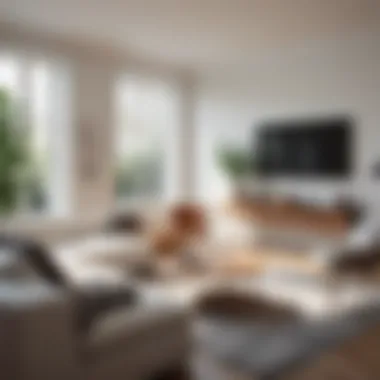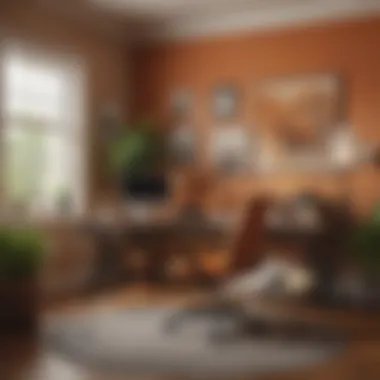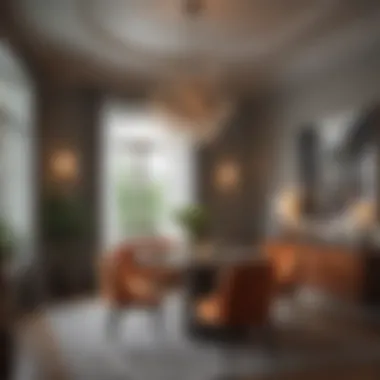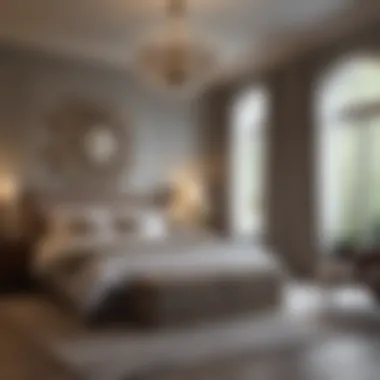A Comprehensive Guide to Home Interior Design Images


Intro
Images are undeniably influential in the realm of home interior design. They serve not just as mere decoration but act as essential tools that can guide decisions, inspire creativity, and help articulate one's personal style. This guide will explore the importance of home interior design images, providing valuable insights for homeowners, design enthusiasts, and anyone looking to transform their living space.
Through a careful examination of various styles and the impact of visual media, we will cover how to effectively utilize images in the design process. Trends in digital platforms and the use of photographs in professional portfolios will also be discussed. The goal is to equip readers with a deeper understanding of how these images can ignite inspiration and offer practical assistance in home transformation projects.
Design Inspiration
Home interior design is intricately linked with visual representation. The images chosen can embody styles, themes, and emotional responses. They beckon a sense of connection between the viewer and the subject, inviting creativity and exploration.
Trending Styles and Themes
Currently, several styles dominate the interior design landscape:
- Modern Minimalism: This style emphasizes simplicity and functionality, using a limited color palette and uncluttered spaces.
- Bohemian Chic: It embraces bold colors and patterns, offering a laid-back and eclectic feel that showcases personal artifacts.
- Scandinavian: Characterized by clean lines, neutral colors, and natural materials, it promotes warmth and comfort.
- Industrial: Rising in popularity, this style features raw materials like exposed bricks, metal finishes, and reclaimed wood.
- Mid-Century Modern: Distinguished by its retro aesthetics, it plays with vibrant colors and organic forms.
Each style communicates a unique narrative and speaks to diverse preferences, enabling homeowners to find inspiration tailored to their tastes.
Color Palettes and Combinations
Color is fundamental to interior design. A well-thought-out color palette can drastically influence the mood of a space. Here are some effective combinations:
- Neutrals with Pops of Color: Using beige or soft greys accented with vibrant cushions or art pieces.
- Monochromatic Schemes: Similar hues in varying shades create a harmonious and sophisticated look.
- Contrasting Colors: Black and white or bold colors like navy paired with bright yellows can create striking visuals.
Understanding the psychology of color can also help in making calculated choices for emotional impact. Choosing the right colors is vital, they can enhance or detract from design intentions.
"Images can shape how we perceive spaces before they even become ours. They are the doorway to our design dreams."
Understanding Home Interior Design Images
In the realm of home interior design, images serve as powerful tools. They are not merely decorative elements; they play a crucial role in influencing perceptions, preferences, and ultimately, decisions. Understanding the significance of these images is essential for anyone looking to transform their space.
The Role of Visual Inspiration
Visual inspiration is a fundamental aspect of interior design. It helps to conceptualize ideas and provide a reference point for what a designed space can achieve. High-quality images showcase various design styles, color palettes, and furniture arrangements. The right image can ignite creativity and serve as a catalyst for change, encouraging individuals to reimagine their spaces.
Moreover, visual inspiration allows potential homeowners and designers to explore options that may not be immediately available in their local environment. By viewing diverse interiors, one can gather ideas that inspire personal creativity and aesthetic preferences. This exposure also demonstrates that there is no one-size-fits-all approach to interior design; rather, it is a personal journey, and the right images facilitate this exploration.
"Images provide a glimpse into the potential of a space, encouraging thoughtful decisions about design elements."
Psychology of Design Images
The psychology behind design images is fascinating. They not only evoke emotions but can also influence how individuals feel about their surroundings. For instance, lighter colors and open spaces may promote feelings of tranquility and calmness, while bold patterns and dark tones can create a sense of drama or intimacy.
Understanding the psychological impact of design images can guide individuals in selecting the right visuals for their projects. Each image can convey a specific atmosphere or feeling, making the selection process more critical.
In addition, familiarity with design psychology aids in anticipating how certain elements resonate with different audiences. For example, images that are heavily laden with textures may appeal to some but overwhelm others. Thus, being aware of how imagery might interact with a viewer's emotions is vital in creating effective design narratives.
Categories of Interior Design Images
In the diverse realm of interior design, categorizing images serves as a pivotal element in streamlining the design process. It allows designers, homeowners, and enthusiasts to navigate through various styles and themes with ease. Each category of interior design images comes with its unique features and significance, providing inspiration and a clearer understanding of how different environments can be designed and decorated.


Residential Spaces
Residential spaces encompass domestic environments. This category includes homes, apartments, townhouses, and even vacation properties. Images of residential interiors usually reflect the personal tastes and styles of those living in these spaces. The portrayal of these images often aims to evoke comfort, warmth, and intimacy. They serve a practical function, inspiring homeowners by showing various arrangement ideas, color schemes, and material selections.
For instance, an image of a contemporary living room with neutral tones and minimalist decor can spark ideas for those who prefer simplicity. Alternatively, visual depictions of bohemian-styled bedrooms filled with eclectic textiles may appeal to those seeking a more vibrant atmosphere. Understanding the characteristics of residential designs helps in making informed decisions when planning modifications or enhancements to one’s home.
Commercial Design
Commercial design images cater to spaces intended for business purposes. This category features offices, retail spaces, restaurants, and hotels. Commercial interior images play a crucial role in branding and functionality. The design of these spaces often prioritizes the impression it leaves on clients and customers. Thus, they must combine practicality with aesthetics to create an inviting atmosphere.
For example, a bright and airy office layout with collaborative spaces may inspire companies focused on innovation and team building. In contrast, images of luxurious hotel lobbies convey a sense of elegance and sophistication, which is essential for attracting guests. This category underscores the importance of effective design in promoting business goals and enhancing customer experience.
Outdoor Areas
Outdoor area images showcase the potential of extending living and working spaces beyond four walls. This category includes patios, gardens, balconies, and terraces. Images in this category focus on how to harmonize nature with architectural elements. They highlight landscaping ideas, outdoor furniture arrangements, and the integration of plants into design.
An image depicting a cozy garden nook with lush greenery can provide inspiration for creating relaxation spots outside. Alternatively, a stylish terrace setup might encourage homeowners to revamp their outdoor entertaining areas. The significance of this category lies in its ability to transform any outdoor space into a functional, enjoyable extension of the interior, contributing to overall lifestyle quality.
In summary, the categorization of interior design images is essential for enhancing understanding, sparking creativity, and facilitating informed design choices in both residential and commercial contexts.
By appreciating these categories, individuals can better explore their preferences and push towards their unique vision in interior design.
Styles in Interior Design
Understanding various styles in interior design is crucial for every homeowner and design enthusiast. Each style offers unique elements and appeals, catering to different tastes and preferences. Identifying a specific style can significantly influence design decisions, as it shapes the overall atmosphere and functionality of a space. Furthermore, recognizing your preferred style can streamline the design process, guiding your choices in furniture, color schemes, and decor.
Modern Aesthetics
Modern aesthetics often emphasize clean lines, simplicity, and a functional approach. This style focuses on minimal ornamentation, showcasing materials like glass, metal, and concrete. Crisp geometric shapes dominate often visuals in modern design, creating spaces that feel open and fresh. This style invokes a sense of calm and clarity, making it popular among contemporary homeowners.
Uncluttered spaces are integral to modern aesthetics. Removing excess items can enhance the visual appeal and functionality of your home. Color palettes tend to be neutral, with occasional bold accents. This nuanced use of color fosters a serene environment, allowing the architecture and furniture to speak for themselves.
Traditional Design
Traditional design draws inspiration from historical styles, offering rich textures and intricate details. This approach showcases a blend of classic and luxurious elements. Wooden furniture with ornate carvings, deep hues, and plush fabrics are essential components of traditional design.
Comfort plays a vital role in this style. Furniture often features soft curves and ample cushioning, inviting occupants to relax and enjoy their space. Accessories such as art pieces, elegant curtains, and decorative rugs further enhance the warmth of traditional interiors. Respect for historical context helps create a timeless ambiance loved by many.
Minimalism vs. Maximalism
Minimalism and maximalism present two contrasting philosophies in design, yet both have their merits. Minimalism values simplicity, focusing on the essentials. This approach often leads to open, decluttered spaces that evoke tranquility. On the other hand, maximalism embraces boldness, advocating for the abundant use of color, pattern, and elements.
Choosing between these styles fundamentally depends on personal preferences and lifestyle needs. Minimalism can often improve functionality and clarity in a home, while maximalism allows for self-expression through diverse decor and unique arrangements. Both styles can create inviting environments when executed thoughtfully.
Eclectic Styles
Eclectic styles celebrate individuality by combining elements from various design movements. This approach allows for creativity and diversity in home decor. Selecting pieces from different eras, cultures, and colors can yield a genuinely unique atmosphere. The key to a successful eclectic design lies in harmony; blending textures, patterns, and colors requires careful consideration.
Important considerations include ensuring that the space does not feel chaotic. Achieving a cohesive look demands an understanding of design principles while integrating contrasting elements. An eclectic style can reflect a homeowner's personality and experiences, making it an appealing choice for many.
Sourcing Interior Design Images


Sourcing interior design images is a critical step for anyone looking to engage with home aesthetics. It forms the foundation of informed design choices, allowing homeowners and enthusiasts to visualize their aspirations. This process is not just about collecting pretty pictures; it involves understanding the context, styles, and potential applications of these images. The right sources can inspire creativity and offer practical solutions for various design challenges.
Considerations around sourcing extend beyond merely gathering images. It is about determining where these images come from, the quality of the content, and the credibility of the sources. Homeowners should prioritize obtaining images that align with their desired outcomes. Moreover, the growing online landscape has transformed how images are shared and accessed, necessitating savvy navigation skills to find what is most relevant.
Online Platforms and Resources
The internet boasts an array of platforms where interior design images can be sourced effectively. Websites such as Pinterest, Houzz, and design blogs serve as treasure troves for visual inspiration. Here, users will find styles ranging from minimalist to maximalist, ensuring a wide variety. These platforms not only present images but also allow one to filter results based on specific needs or preferences.
For example, Pinterest offers tailored recommendations based on interests. This personalization can lead to discovering unique designs that may not appear in traditional resources. Additionally, many of these platforms enable users to create boards or collections, improving the organization of thoughts and ideas.
Professional Portfolios
Exploring professional portfolios can be another excellent avenue for sourcing interior design images. Interior designers often showcase their work on personal websites and platforms like Behance. These portfolios provide not only beautiful images, but also detailed insights into the design process. Homeowners and enthusiasts can better understand how certain elements come together to create cohesive spaces.
A professional portfolio can often reveal not just the final outcome, but also the designer’s philosophy, methodologies, and even challenges faced during the design. This context can help homeowners reflect on their values and preferences, leading to more informed decisions.
Social Media as a Tool
Social media serves as a dynamic tool for sourcing interior design images. Platforms like Instagram and Facebook host a vast array of accounts dedicated to design inspiration. Following designers, brands, and influencers can provide a continuous stream of fresh ideas and trends.
Engaging with social media does not solely require passive consumption. Users can actively participate by joining groups focused on interior design, where they can share and receive feedback on design images. This interaction can lead to valuable insights and even collaborations, enhancing the overall design journey.
The Impact of Technology on Interior Design Images
Technology has significantly influenced home interior design images in various ways. Its integration has transformed how designers, homeowners, and enthusiasts interact with design imagery. Understanding this impact is crucial for anyone looking to make informed decisions about their living spaces. Advancements in technology have made access to high-quality imagery easier while providing innovative tools for visualization and implementation.
Digital Media Trends
Digital media trends play an essential role in shaping how interior design images are curated and consumed. Social media platforms like Instagram and Pinterest offer a plethora of design ideas. These platforms allow users to share their own spaces, seeking inspiration and showcasing creativity. As a result, trends emerge rapidly. The community aspect encourages engagement and introduces diverse styles that might not receive traditional media coverage. Users can easily save and share images, contributing to a catalog of designers’ work and personal styles.
The following are key digital media trends affecting interior design images:
- The rise of influencers who shape expectations and preferences in design.
- A focus on DIY projects, where users are encouraged to apply their skills in practical situations.
- Increased use of hashtags and categorization for easier discovery of content.
- Tools and apps that allow for virtual staging or layout planning.
Virtual Reality Experiences
Virtual reality (VR) has provided an immersive way to interact with interior design images. Instead of assuming what a design might look like, technology allows users to experience spaces authentically, gaining a better sense of scale and ambiance. Homeowners can walk through potential renovations or new designs in a virtual setting. This capability helps them make more informed decisions.
The advantages of VR in interior design include:
- Enhanced visualization: Users can see how colors, textures, and layouts influence their spaces.
- Reduced guesswork: VR eliminates uncertainty in the design process. Homeowners can make choices based on realistic scenarios.
- Increased engagement: Users often feel a stronger connection to spaces when experiencing them in a virtual environment.
- Cost efficiency: Making design changes in a virtual space can save time and resources in real projects.
"Virtual reality stands to revolutionize how we perceive and implement interior design, making the process more interactive and engaging."
Practical Applications of Design Images
The use of design images is critical in various contexts within the realms of interior design. They serve not just as aesthetic references but also as pivotal tools that can guide and influence decisions. Homeowners and designers alike rely heavily on visuals to relay concepts and ideas. Images allow for the crystallization of abstract ideas into concrete visions.
When discussing practical applications, it is essential to highlight how design images aid in the decision-making process and enhance creative output. These images can define a space, influence color choices, and indicate desired themes or styles. Moreover, they help to communicate ideas clearly within teams or with clients, avoiding misunderstandings that could arise from mere verbal descriptions.
Influencing Design Decisions


Design images have a profound impact on how individuals make choices regarding their spaces. They can inspire transformations that reflect personal taste or current trends. Viewing a broad array of styles through images allows for informed adaptations tailored to unique residential needs.
The process often begins with collection. Homeowners may gather images that resonate with them, whether from magazines, online resources, or social media platforms. This initial stage is crucial. An image that evokes an emotional response can guide subsequent selections, be it furniture, color schemes, or layouts. For instance, a photograph of a cozy living room might prompt a homeowner to choose soft textures and muted colors for comfort.
Such visual stimuli can also help mitigate the overwhelming nature of design selections. By focusing on a curated selection of images, decision fatigue is minimized. Instead of getting lost in the multitude of options available, one can refer back to specific images that were influential. It is about narrowing the scope based on preferences illustrated in the visuals.
Mood Board Creation
Mood boards are one of the most effective methods to harness the power of design images. They serve as a collage that encapsulates themes, colors, and styles that a person wishes to explore for a project. The creation of mood boards enables designers to visualize the overall feel of a space before committing to any elements.
Creating a mood board typically involves assembling a variety of images that represent the desired aesthetic. This may include pictures of furnishings, fabrics, color swatches, or even artwork. By moving images around and rearranging elements on the board, one can experiment with different compositions and ideas. It allows for an organic flow of thought, leading to deeper understanding of how various components contribute to the overall design.
Additionally, mood boards are valuable communication tools between clients and designers. They can help convey visions effectively, ensuring that everyone involved in the design process is on the same page about the intended outcome. A well-constructed mood board can serve as a visual agreement, helping avoid potential disagreements as the project moves forward.
"Images are not just decoration; they provide a pathway to creativity and collaboration in interior design."
Ethical Considerations in Using Design Images
In the ever-evolving field of home interior design, images serve as a powerful tool for inspiration and guidance. However, ethical considerations in using design images are paramount. Engaging with these visuals requires a keen awareness of copyright laws and sourcing principles. Understanding these elements ensures that designers and homeowners respect the creative rights of original artists while avoiding potential legal issues.
Copyright Issues
Copyright laws are crucial in the realm of design images. These laws protect the rights of creators, ensuring that they receive recognition and compensation for their work. In many cases, using images without permission can lead to serious legal ramifications.
- Understand ownership: The first step is to determine who owns the image. Photographers, artists, and designers commonly retain ownership unless they explicitly transfer rights.
- Seek permission: Always seek permission before using someone else's image for personal or commercial projects. This could be in the form of a license agreement or written consent.
- Attribution: When permitted to use an image, providing proper attribution is essential. This acknowledges the work of the creator and promotes ethical sharing practices.
- Creative Commons: Utilizing images that fall under the Creative Commons license can provide an easy alternative. These images are free to use under certain conditions, usually involving appropriate credit to the creator.
"Respecting intellectual property rights fosters a culture of creativity and collaboration in the design community."
Sourcing Responsibly
Sourcing design images responsibly means prioritizing integrity and respect for original content creators. This goes beyond simply avoiding copyright infringement.
- Use reputable platforms: Consider sourcing images from established platforms. Websites like Unsplash, Pexels, and Shutterstock offer high-quality images that often come with clear usage guidelines.
- Purchase stock images: For professional projects, purchasing stock images is a wise decision. Many companies provide access to vast libraries of images for a fee, granting usage rights in the process.
- Support independent artists: When possible, source images directly from artists or photographers. This not only ensures ethical usage but also supports individual creators who contribute to the design ecosystem.
- Be selective: Always evaluate the quality and relevance of images. Selecting well-composed, high-resolution visuals enhances the overall aesthetic of a project and reflects a commitment to quality.
In summary, navigating the ethical landscape of using design images is essential for any homeowner or interior design enthusiast. By understanding copyright issues and sourcing responsibly, individuals can contribute to a culture of respect and creativity within the design community.
Future Trends in Home Interior Design Images
Understanding future trends in home interior design images is essential for homeowners, designers, and enthusiasts alike. Visual representations of design not only shape aesthetic preferences but also reflect societal values and technological advancements. As the landscape of interior design continues to evolve, being aware of these trends can help in making informed decisions that align with personal style and contemporary environmental considerations.
Sustainability and Eco-Focused Design
Sustainability in interior design emphasizes using resources that are environmentally friendly and socially responsible. This focus influences how spaces are visualized and executed. Homeowners are increasingly drawn to materials that are renewable, recycled, or sustainably sourced.
Some examples of eco-friendly materials include bamboo flooring, reclaimed wood furniture, and low-VOC paints. Additionally, design images often feature greenery and biophilic elements. This illustrates a connection to nature that promotes relaxation and wellbeing. Homeowners can draw inspiration from these images, incorporating similar sustainable elements into their projects.
The benefits of sustainability in design images extend beyond aesthetics. They also help raise awareness about climate change and the impact of consumer choices. By utilizing images that advocate eco-friendly practices, designers can foster a more conscious approach to home interior design.
"Sustainable design in images influences choices, leading to a healthier planet and living space."
Emerging Technologies
The impact of emerging technologies in home interior design images is becoming increasingly significant. Advancements such as augmented reality (AR) and virtual reality (VR) allow homeowners to visualize spaces as never before. With these technologies, users can see how different colors, textures, and layouts might look in their homes.
Using AR applications, potential buyers can "try out" various design ideas without committing to any physical changes. This leads to more informed decisions and can also reduce waste during the renovation process. Furthermore, design software tools are becoming more accessible, allowing more people to experiment with their visions.
In addition, AI algorithms analyze trends and create tailored design images based on individual preferences. This integration of technology simplifies the design process and creates bespoke solutions for homeowners.
In summary, staying abreast of future trends in home interior design images enables significant opportunities for creativity and sustainability. By embracing these themes, one can foster an environment that not only meets aesthetic desires but also responds to the pressing needs of our times.



